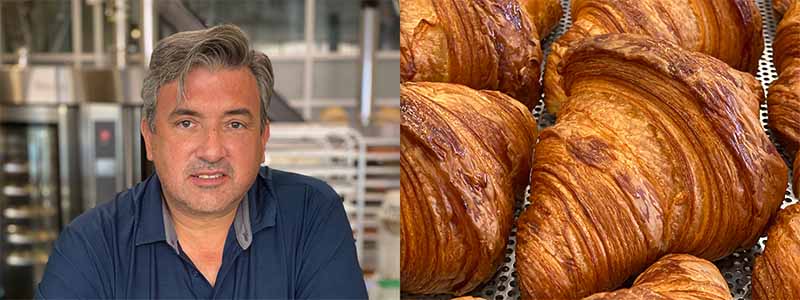

Armando Lacayo points out a vintage bakery cart in one of his two, soon to be three, bakeries in San Francisco; it had been owned by his great-grandparents, the Arsicaults, and used in their namesake bakery in France more than 100 years ago.
“They took my grandfather out of school when he was 14 to work at the bakery,” says Lacayo. “He was a baker only until his 20s, so he never made me bread, but he taught me how to recognize good bread.”
Lacayo came to America as a college student, earning a degree in mathematics and an MBA and eventually working in finance on Wall Street. But his search for a good croissant in the U.S. came up short, so he ventured to make his own.
“My first attempt was in New York in the middle of summer, in a kitchen that was the only room without air conditioning, and it was really bad. Nevertheless, I persevered, and my recipe got better.”
So much better that one year into opening his first bakery in San Francisco, Arsicault Bakery, Lacayo earned the prestigious title of “Best New Bakery in America” by Bon Appétit magazine, leading to a perpetual queue of enthusiastic croissant lovers that persists a decade later.
Here, he tells us how his banking career prepared him for bakery success.
From banker to baker
I left my job in finance in 2014 and decided to switch gears. I knew the owner of a café in San Francisco and we agreed to share space in their café. I made croissants absolutely every day for six months. I had a table, a mixer, a small oven, a small proofer, and a manual dough sheeter. I was cranking the dough sheeter by hand!
I sold my first croissants, and people liked them, so I started looking around for an existing bakery for sale. I found one on Arguello Boulevard in San Francisco. I bought the business, and the moment I signed, everybody who was working there told me they had better opportunities. I was by myself.
My nephew visited from D.C. for his spring break and he helped me in the kitchen until three in the morning for a week. At 7AM, we opened. The wife of a friend worked the front register, and that's how we got started. Here’s what I wish I knew then and my advice for new business owners opening a bakery, cafe or restaurant.
Don’t cut corners as you scale.
I’ve seen many bakeries and restaurants do a great job when they first open, but then let quality slip. Something happens. Maybe they cut corners. I went into this business because I thought I had a good product that I wanted to share. I also wanted the business challenge of scaling things up as long as I could maintain quality.
In 2016, when Bon Appétit magazine decided we were the best new bakery in America, that really changed everything. Suddenly we had a line, and fortunately that line is still there. The very first day, people bought everything they could. Very quickly, we said, "Okay, we’ll limit six croissants per person," then we limited to five, four, then three. We worked very hard to increase our production but always stayed focused on quality. An extra sale was never going to justify a below-par product. Eventually, we were able to grow more sustainably to accommodate the crowds. It just may have taken a little longer.
We bake throughout the day. That's a big part of our process and what people expect. Our customers know they're going to get something super fresh, and hot a lot of the time, and we're going to maintain the same quality and process at our new bakery, our third in San Francisco, at Mission Rock.
Find ways to be more efficient instead.
My last job in finance, we would invest your money, and we would tell you our motto was to be OSD: objective, systematic and disciplined. It's just a fancy way to say, "We're going to try to be smart about what we’re doing." But so much of that same way of thinking applies to the bakery and I’m sure to other businesses. At the very beginning, the emphasis was on being systematic. We really had to start thinking about a production schedule and making sure we were very consistent. That allowed us to increase production and improve quality.
Don’t sweat the setbacks but document them.
About four years ago, we had issues with lamination. For some reason, it was not as good as it had been.
I tried to change the temperature, the temperature in the oven, the proofing temperature, the dough. But, eventually, I realized, "No, it's the butter." The butter we were using was fantastic most of the year, but sometimes, we suspect it was seasonal, it would get too hard and become brittle.
A big part of what makes our croissant special is that we give the croissant three turns. Most bakeries only give it two turns. With three turns, a croissant is flakier, there are more layers, but the butter needs to be very malleable. Periodically, the butter we were using was not extensible, it would crack, and you’d lose some of the layers. We switched butters, and now we're consistent, and everything's good. It took looking at the entire process. The product was still good before we identified the issue, but it was not up to our standards.
All that was only possible because I have a fantastic team. We were able to execute and document our process. If something goes wrong, we can identify more easily what the issue is, and we strive for consistency. Because, if we can make a really great croissant, we should be able to do it every day.
Embrace competition.
The San Francisco Chronicle recently published an article saying we're the best croissant in the Bay Area out of the 50 bakeries that the author visited. The description he gives of our croissant is fantastic and gives me goosebumps, but also puts a lot of pressure on us. San Francisco is a place known for good bread and good pastries. Getting such recognition when you are surrounded by so many great bakeries is so rewarding. It also allows me to concentrate on what I like to make. I'll never make a cupcake. I'll never make a cheese danish. But if you want a croissant, come to me.
Don't try to please everyone. There are always people telling me, "Oh, this is overbaked. This is underbaked." The first baker I hired, one day I realized he was putting more sugar in my croissant dough than the recipe called for because, "Oh, there's not enough sugar in your croissant." Well, he didn't stay very long. Our croissant dough has 8 percent sugar as a proportion of the flour weight. Most croissants are between 12 and 15 percent. I like it less sweet, and I think it works really well, and I'm not going to change that. It's always nice when people give me advice, but I have to keep doing it my way, and hopefully you like it!